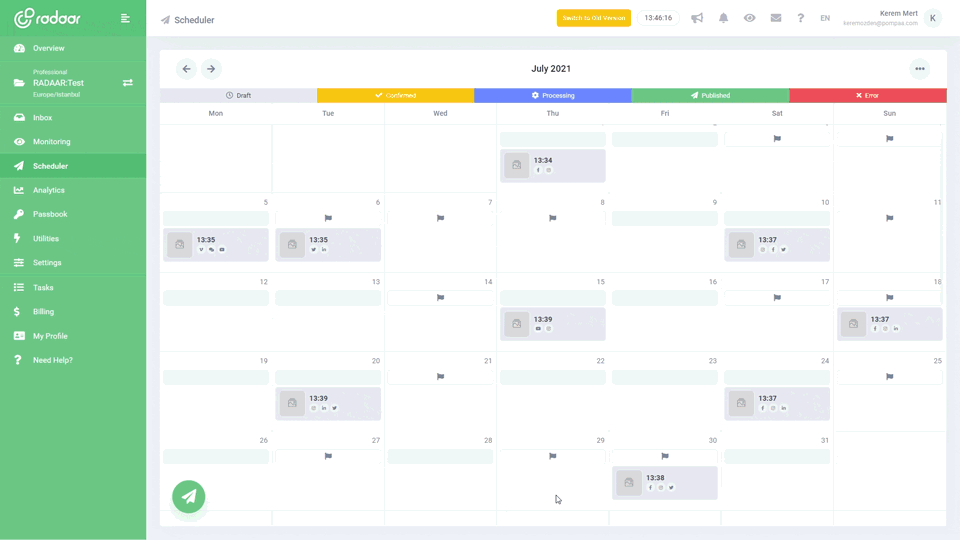Are you choosing the right social platforms for business growth?
Discover how to choose the right social media platforms to fuel your business growth in 2025. Uncover the strengths, audiences, and strategies behind the top 10 social channels and learn expert tips for mastering your social marketing game.
LEARN MORE LAUNCH DEMO NOW Choosing the right social media platforms for your business has never been more important. With over 5 billion active social users in 2025 and new platforms emerging alongside established giants, the possibilities (and challenges) can feel overwhelming. Each platform—whether it’s LinkedIn for B2B networking, TikTok for viral reach, or Instagram for visual storytelling—offers unique opportunities to connect with your ideal customers and strengthen your brand. But with so many choices, how do you know which channels truly support your business goals?
In this guide, we’ll break down the must-know strengths, target audiences, and best use cases for the top 10 social media platforms. You’ll learn why businesses need social media marketing, what factors to consider when choosing your channels, and how to match your content with the right platform. Whether you’re a startup aiming for quick awareness or a seasoned brand ready to scale, this post will equip you with the insights and actionable strategies needed to guarantee your social media efforts deliver real business growth.
In this guide, we’ll break down the must-know strengths, target audiences, and best use cases for the top 10 social media platforms. You’ll learn why businesses need social media marketing, what factors to consider when choosing your channels, and how to match your content with the right platform. Whether you’re a startup aiming for quick awareness or a seasoned brand ready to scale, this post will equip you with the insights and actionable strategies needed to guarantee your social media efforts deliver real business growth.
Table of Contents
- Which social media platforms deliver the highest engagement?
- How can platforms help brands reach their audience easier?
- What makes content strategy unique across different social networks?
- How do professional networks differ from visual-first channels?
- Can emerging platforms truly challenge established social networks?
- How should brands decide where to focus resources effectively?
- What role does audience demographics play in platform choice?
- Will integrating multiple platforms boost business marketing results?
- Ready to build a winning strategy across top platforms?
Which social media platforms deliver the highest engagement?
Social media platforms like Instagram, TikTok, and Facebook consistently deliver the highest engagement rates for businesses aiming to grow their online presence. Visual-first platforms such as Instagram and TikTok thrive on short-form video and interactive content, driving more likes, shares, and comments. Facebook remains strong due to its broad user base and versatile content formats, enabling community interaction and brand loyalty. Choosing a platform with high engagement can significantly boost your brand’s visibility and foster meaningful customer connections.
How can platforms help brands reach their audience easier?
Social media platforms help brands reach their audience faster by offering powerful targeting tools and tailored content delivery. With features like real-time engagement and analytics, businesses can efficiently connect with the right people at the right time. Platforms such as Facebook, Instagram, and LinkedIn enable brands to build stronger relationships and boost brand awareness. This makes social media marketing an essential strategy for sustainable business growth.
What makes content strategy unique across different social networks?
A content strategy must be tailored to each social media platform, as every network attracts unique audiences and encourages different content formats. Visual platforms like Instagram and Pinterest thrive on high-quality imagery, while LinkedIn demands a professional tone and in-depth articles. TikTok and YouTube focus on video storytelling, catering to users who prefer dynamic, engaging content. By customizing your approach to match each social network’s strengths, businesses maximize engagement and brand visibility.
How do professional networks differ from visual-first channels?
Professional networks like LinkedIn are designed for business-focused interactions, enabling brands to build authority, share thought leadership, and connect with industry peers and decision-makers. In contrast, visual-first channels such as Instagram and Pinterest prioritize stunning imagery, storytelling, and lifestyle content to engage wide audiences and drive brand discovery. Choosing between these platforms depends on your business objectives—opt for professional networks if you aim for B2B growth, lead generation, and credibility, or choose visual-first channels to boost brand awareness and showcase products creatively. Understanding these core differences helps you select the right social media platform for sustainable business growth.
Can emerging platforms truly challenge established social networks?
Emerging social platforms like Threads and Bluesky are gaining attention for their innovative features and community-first approaches. While established networks such as Facebook and Instagram still dominate in terms of user base and brand recognition, new platforms offer businesses fresh opportunities to reach niche audiences and experiment with different content formats. The key to long-term success lies in adaptability, as trends and user preferences can shift quickly. Ultimately, a balanced social media strategy includes both established and emerging channels to maximize business growth.
How should brands decide where to focus resources effectively?
Brands aiming for business growth must take a strategic approach when allocating resources to social platforms. The most successful companies start by understanding where their target audience spends time online and how those users prefer to engage. By analyzing customer demographics, behavior, and platform-specific strengths, brands can pinpoint which networks are most likely to deliver positive ROI. Instead of spreading efforts thin, it's smarter to focus resources on platforms that align strongly with business goals and audience preferences.
Another key factor is the type of content your brand excels at producing. For example, visually-driven brands may achieve better engagement on Instagram or Pinterest, while B2B companies often see the most impact on LinkedIn. Additionally, monitoring competitors’ strategies and tracking your own historical performance can provide valuable insights into where opportunities exist. Ultimately, effective resource allocation requires ongoing analysis, experimentation, and the flexibility to adapt as audience habits and platform features evolve.
Another key factor is the type of content your brand excels at producing. For example, visually-driven brands may achieve better engagement on Instagram or Pinterest, while B2B companies often see the most impact on LinkedIn. Additionally, monitoring competitors’ strategies and tracking your own historical performance can provide valuable insights into where opportunities exist. Ultimately, effective resource allocation requires ongoing analysis, experimentation, and the flexibility to adapt as audience habits and platform features evolve.
What role does audience demographics play in platform choice?
Audience demographics play a crucial role in selecting the right social media platform for your business. Understanding the age, gender, location, and interests of your target audience helps you focus your marketing efforts where they will have the most impact. For example, platforms like Instagram and TikTok attract a younger crowd, while LinkedIn is ideal for professionals and B2B connections. Aligning your platform choice with your audience demographics ensures better engagement and stronger business growth.
Will integrating multiple platforms boost business marketing results?
Integrating multiple social media platforms can significantly boost your business marketing results by expanding your reach and improving brand visibility. By leveraging each platform’s unique features and audience demographics, you can create a more targeted and cohesive marketing strategy. Consistently engaging across channels also helps nurture trust and long-term relationships with potential customers. However, it is crucial to choose platforms that align with your business goals for the best ROI.
Ready to build a winning strategy across top platforms?
Ready to build a winning strategy across top platforms?
Choosing the right social platforms can make all the difference in accelerating your business growth. By understanding each platform's unique strengths and aligning them with your audience and content goals, you set the stage for authentic connections and meaningful engagement. Don’t be afraid to experiment with emerging platforms like Threads or Bluesky, or double down on proven favorites like LinkedIn and Instagram. The key is to be strategic and consistent—tailoring your message to where your customers spend their time and how they like to interact.
If managing multiple accounts feels overwhelming, consider streamlining your workflow with robust tools like RADAAR. RADAAR empowers you to schedule content, monitor engagement, and analyze your performance across all the major social platforms from a single dashboard. With the right strategy and smart tools in hand, you’ll have everything you need to grow your business, boost your brand visibility, and build lasting relationships online. Now’s the perfect time to refine your strategy and make every post count!
Choosing the right social platforms can make all the difference in accelerating your business growth. By understanding each platform's unique strengths and aligning them with your audience and content goals, you set the stage for authentic connections and meaningful engagement. Don’t be afraid to experiment with emerging platforms like Threads or Bluesky, or double down on proven favorites like LinkedIn and Instagram. The key is to be strategic and consistent—tailoring your message to where your customers spend their time and how they like to interact.
If managing multiple accounts feels overwhelming, consider streamlining your workflow with robust tools like RADAAR. RADAAR empowers you to schedule content, monitor engagement, and analyze your performance across all the major social platforms from a single dashboard. With the right strategy and smart tools in hand, you’ll have everything you need to grow your business, boost your brand visibility, and build lasting relationships online. Now’s the perfect time to refine your strategy and make every post count!
SOCIAL MEDIA SCHEDULER
Plan and publish...
Plan and publish your content for Facebook, Instagram, Twitter, and LinkedIn from one simple dashboard.
LEARN MORE FREQUENTLY ASKED QUESTIONS
Are you choosing the right one?
Find clear answers to the most common questions about picking the best social platforms for business growth. Discover tips on audience, platform features, and strategy in this FAQ section.
RELATED BLOG POSTS
All the tips & tricks you'll need...
Get the fresh tips and tricks you'll need to ace social media marketing.













